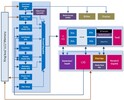AMD Radeon R2 (Stoney Ridge) vs Intel HD Graphics (Ivy Bridge) vs Intel HD Graphics 5000
AMD Radeon R2 (Stoney Ridge)
► remove from comparison
Die AMD Radeon R2 (Stoney Ridge) ist eine integrierte Grafikeinheit der schwächsten mobilen Stoney-Rdige-APUs. Sie kommt zum Launch im AMD E2-9010 zum Einsatz und bietet wahrscheinlich 128 Shader bei 600 MHz. Je nach konfigurierter TDP und eingesetztem Hauptspeicher kann die Leistung deutlich variieren.
Architektur und Features
Die Radeon R4 bietet zwei Kerne der dritten GCN Generation (in der Presse oft als GCN 1.2 oder 2.0 bezeichnet). Damit ist sie sehr ähnlich zu dem Tonga Desktop Chip und bietet DirectX 12 (FL 12_0) Hardware-Support. Weiters können auch per Mantle, OpenGL und OpenCL die Grafikkerne angesprochen werden. Außerdem unterstützt die Grafikkarte den HSA 1.0 Standard und kann damit effizient in Verbindung mit den CPU Kernen genutzt werden. Technisch entspricht die GPU exakt dem Vorgänger Carrizo.
Die Videoeinheit beinhaltet den UVD 6 (Unified Video Decoder), welcher HVEC/H.265 und 4K hardwareunterstützt dekodieren kann. Mehr Details dazu finden Sie in unserem Stoney-Ridge Artikel.
Leistungsaufnahme
Je nach Modell und konfigurierter TDP (cTDP) ist der in 28 nm gefertigte Chip mit 10 bis 15 Watt spezifiziert. Damit eignet er sich für den Einsatz in schlanken und leichten Notebooks.
Intel HD Graphics (Ivy Bridge)
► remove from comparison
Die Intel HD Graphics ist eine in den Ivy Bridge Prozessoren integrierte Grafikkarte. Sie kommt in den mobilen Celeron- und Pentium-Modellen zu Einsatz. Im Vergleich zur stärkeren Intel HD Graphics 4000, ist die HD Graphics deutlich abgespeckt und bietet weniger Execution Units (6 EUs) und Texture Sampler (nur einer). Daher ist die Performance deutlich geringer und liegt nur etwas oberhalb der alten Intel HD Graphics 2000. Je nach Prozessor weist die HD Graphics eine unterschiedliche Basis- und Turbo-Taktrate auf.
Da die Leistung nur zwischen der HD Graphics 2000 und 3000 liegt, ist die Ivy Bridge GT1 nur für ältere und anspruchslose Spiele ausreichend. Intel selbst gibt eine Geschwindigkeit 10-15% über der alten HD Graphics 2000 in Sandy Bridge CPUs an. Unsere Benchmarks (siehe weiter unten) zeigen eine Performance auf dem Niveau integrierter Einstiegslösungen von AMD wie der Radeon HD 8210.
Eine Besonderheit der Ivy Bride Grafikkerne ist, dass nur 4x MSAA von der Hardware unterstützt wird. 2x MSAA wird per Software berechnet und geht durch die 4x MSAA Pipeline. Daher empfiehlt sich der Einsatz des gleich schnellen 4x MSAA.
Auch der integrierte Videodecoder genannt Multi Format Codec Engine (MFX) wurde kräftig überarbeitet und soll nun sogar mehrere 4K Videos parallel dekodieren können (ev. nur in den High-End Modellen). DXVA Checker gibt weiterhin die Formate MPEG2, VC1, WMV9 und H264 als unterstützt an. QuickSync zum schnellen Transkodieren von Videos wurde ebenfalls verbessert und soll nun schneller bei gleichzeitig höherer Qualität laufen.
Ebenfalls neu ist die Unterstützung für drei unabhängige Bildschirme. Bis Sandy Bridge waren nur zwei möglich und lediglich die AMD Grafikkarten mit Eyefinity Support bieten mehr als zwei Anschlüsse für Notebooks (jedoch nur mit DisplayPort).
Aufgrund der Integration in den mit 22nm gefertigten Prozessor und die halbierte Shaderzahl ist der Stromverbrauch relativ gering und eignet sich auch für flache und kleine Notebooks.
Intel HD Graphics 5000
► remove from comparison
Die Intel HD Graphics 5000 (GT3) ist eine Prozessorgrafikkarte in den CPUs der Haswell-Generation. Zunächst wird die GPU in einigen ULV-Modellen mit 15 Watt TDP eingesetzt (z.B. Core i5-4250U). Sie stellt die maximale Ausbaustufe der integrierten Grafikeinheit dar (40 Execution Units), muss im Gegensatz zur Iris Pro (GT3e) aber auf den zusätzlichen eDRAM-Cache verzichten. Abhängig von der Taktrate (diese fällt bei den 15-Watt-Modellen relativ niedrig aus) sowie der Hauptspeicheranbindung kann sich die Performance von Modell zu Modell leicht unterscheiden.
Der Grafikkern wurde im Vergleich zum Intel HD Graphics 4000 der Ivy-Bridge-Generation in verschiedenen Punkten weiterentwickelt. So unterstützt die GPU nun mit DirectX 11.1, OpenCL 1.2 und OpenGL 4.0 alle wichtigen aktuellen Standards. Auch ein verbesserter Decoder für 4K-Videos sowie ein überarbeiteter Quick-Sync-Encoder sind mit an Bord.
Die Performance der HD Graphics 5000 liegt im 3DMark 11 um etwa 50 Prozent oberhalb der HD 4000 der Vorgängergeneration. In Spielen fällt die Mehrleistung dagegen deutlich geringer aus: Bei gleichzeitiger Belastung der CPU kann die Grafikeinheit ihren starken Turbo-Boost nur sehr eingeschränkt ausschöpfen, da die niedrige TDP der ULV-Modelle (15 Watt) zu limitieren beginnt. Obwohl die HD 5000 mit 40 Execution Units (EUs) doppelt so viele Ausführungseinheiten wie die HD Graphics 4600 besitzt (HD 4000: 16 EUs), ist die Grafikleistung darum dennoch etwas schwächer. Unterm Strich liegt die HD 5000 damit knapp hinter AMDs Radeon HD 7660G und auf dem Niveau einer dedizierte Radeon HD 7650M. Aktuelle 3D-Spiele (Stand 2013) können in niedrigen, seltener auch mittleren Einstellungen flüssig dargestellt werden.
Der Stromverbrauch ist dank des 22-Nanometer-Prozesses mit Tri-Gate-Transistoren relativ gering und wird dynamisch vom TDP-Budget des gesamten Chips abgezweigt. Die HD 5000 wird zunächst in einigen Dual-Core-Modellen der 15-Watt-Klasse (ULV) eingesetzt, beispielsweise dem Core i7-4650U.
Weitere Details zur Grafikkartenarchitektur der Haswell Generation finden Sie in unserem Artikel zur Vorstellung der Haswell-Generation.
| AMD Radeon R2 (Stoney Ridge) | Intel HD Graphics (Ivy Bridge) | Intel HD Graphics 5000 | ||||||||||||||||||||||||||||||||||||||||||||||||||||||||||||||||||||||||||||||||||||||||||||||||||||||||||||||||||||||||||||||||||||||||||||||||||||||||||
| HD Graphics Serie |
|
|
| |||||||||||||||||||||||||||||||||||||||||||||||||||||||||||||||||||||||||||||||||||||||||||||||||||||||||||||||||||||||||||||||||||||||||||||||||||||||||
| Codename | Stoney Ridge | Ivy Bridge GT1 | Haswell GT3 | |||||||||||||||||||||||||||||||||||||||||||||||||||||||||||||||||||||||||||||||||||||||||||||||||||||||||||||||||||||||||||||||||||||||||||||||||||||||||
| Architektur | GCN 1.2/2.0 | Gen. 7 Ivy Bridge | Gen. 7.5 Haswell | |||||||||||||||||||||||||||||||||||||||||||||||||||||||||||||||||||||||||||||||||||||||||||||||||||||||||||||||||||||||||||||||||||||||||||||||||||||||||
| Pipelines | 128 - unified | 6 - unified | 40 - unified | |||||||||||||||||||||||||||||||||||||||||||||||||||||||||||||||||||||||||||||||||||||||||||||||||||||||||||||||||||||||||||||||||||||||||||||||||||||||||
| Kerntakt | 600 (Boost) MHz | 350 - 1100 (Boost) MHz | 200 - 1100 (Boost) MHz | |||||||||||||||||||||||||||||||||||||||||||||||||||||||||||||||||||||||||||||||||||||||||||||||||||||||||||||||||||||||||||||||||||||||||||||||||||||||||
| Speicherbandbreite | 64 Bit | 64/128 Bit | 64/128 Bit | |||||||||||||||||||||||||||||||||||||||||||||||||||||||||||||||||||||||||||||||||||||||||||||||||||||||||||||||||||||||||||||||||||||||||||||||||||||||||
| Shared Memory | ja | ja | ja | |||||||||||||||||||||||||||||||||||||||||||||||||||||||||||||||||||||||||||||||||||||||||||||||||||||||||||||||||||||||||||||||||||||||||||||||||||||||||
| API | DirectX 12 (FL 12_0), OpenGL 4.4 | DirectX 11.0, Shader 5.0 | DirectX 11.1, Shader 5.0, OpenGL 4.0 | |||||||||||||||||||||||||||||||||||||||||||||||||||||||||||||||||||||||||||||||||||||||||||||||||||||||||||||||||||||||||||||||||||||||||||||||||||||||||
| Stromverbrauch | 15 Watt | |||||||||||||||||||||||||||||||||||||||||||||||||||||||||||||||||||||||||||||||||||||||||||||||||||||||||||||||||||||||||||||||||||||||||||||||||||||||||||
| Transistors | 3.1 Billion | |||||||||||||||||||||||||||||||||||||||||||||||||||||||||||||||||||||||||||||||||||||||||||||||||||||||||||||||||||||||||||||||||||||||||||||||||||||||||||
| Herstellungsprozess | 28 nm | 22 nm | 22 nm | |||||||||||||||||||||||||||||||||||||||||||||||||||||||||||||||||||||||||||||||||||||||||||||||||||||||||||||||||||||||||||||||||||||||||||||||||||||||||
| Features | UVD 6, VCE | QuickSync | ||||||||||||||||||||||||||||||||||||||||||||||||||||||||||||||||||||||||||||||||||||||||||||||||||||||||||||||||||||||||||||||||||||||||||||||||||||||||||
| Erscheinungsdatum | 01.06.2016 | 01.10.2012 | 05.06.2013 |
|
|
| ||||||||||||||||||||||||||||||||||||||||||||||||||||||||||||||||||||
Benchmarks
3DM Vant. Perf. total + AMD Radeon R2 (Stoney Ridge)
specvp11 snx-01 + Intel HD Graphics (Ivy Bridge)
Cinebench R15 OpenGL 64 Bit + AMD Radeon R2 (Stoney Ridge)
GFXBench T-Rex HD Offscreen C24Z16 + AMD Radeon R2 (Stoney Ridge)
Average Benchmarks AMD Radeon R2 (Stoney Ridge) → 100% n=17
Average Benchmarks Intel HD Graphics (Ivy Bridge) → 66% n=17
Average Benchmarks Intel HD Graphics 5000 → 183% n=17
* Smaller numbers mean a higher performance
1 This benchmark is not used for the average calculation
Spiele-Benchmarks
Die folgenden Benchmarks basieren auf unseren Spieletests mit Testnotebooks. Die Performance dieser Grafikkarte bei den gelisteten Spielen ist abhängig von der verwendeten CPU, Speicherausstattung, Treiber und auch Betriebssystem. Dadurch müssen die untenstehenden Werte nicht repräsentativ sein. Detaillierte Informationen über das verwendete System sehen Sie nach einem Klick auf den fps-Wert.

Team Fortress 2
2017
Rocket League
2017
Farming Simulator 17
2016
Civilization VI
2016
Overwatch
2016
Rainbow Six Siege
2015
World of Warships
2015
Metal Gear Solid V
2015
Dota 2 Reborn
2015
Dirt Rally
2015
GTA V
2015
Battlefield Hardline
2015
Evolve
2015
F1 2014
2014
The Evil Within
2014
Ryse: Son of Rome
2014
Alien: Isolation
2014
Fifa 15
2014
Sims 4
2014
Risen 3: Titan Lords
2014
GRID: Autosport
2014
Watch Dogs
2014
Titanfall
2014
Thief
2014
X-Plane 10.25
2013
Call of Duty: Ghosts
2013
Battlefield 4
2013
F1 2013
2013
Fifa 14
2013
Total War: Rome II
2013
Dota 2
2013
Company of Heroes 2
2013
Metro: Last Light
2013
BioShock Infinite
2013
Tomb Raider
2013
Crysis 3
2013
Dead Space 3
2013
Far Cry 3
2012
Assassin´s Creed III
2012
Hitman: Absolution
2012
Dishonored
2012
Fifa 13
2012
F1 2012
2012
Torchlight 2
2012
Guild Wars 2
2012
Counter-Strike: GO
2012
Dirt Showdown
2012
Diablo III
2012
Fifa 12
2011
Dirt 3
2011
StarCraft 2
2010Average Gaming AMD Radeon R2 (Stoney Ridge) → 100%
Average Gaming 30-70 fps → 100%
Average Gaming Intel HD Graphics (Ivy Bridge) → 75%
Average Gaming 30-70 fps → 114%
Average Gaming Intel HD Graphics 5000 → 177%
Average Gaming 30-70 fps → 170%
| AMD Radeon R2 (Stoney Ridge) | low | med. | high | ultra | QHD | 4K |
|---|---|---|---|---|---|---|
| Team Fortress 2 | 19.7 | 18.5 | ||||
| Rocket League | 30.8 | |||||
| Prey | 9.4 | |||||
| Farming Simulator 17 | 43.5 | 26.4 | ||||
| Civilization VI | 21.6 | 8.5 | ||||
| Overwatch | 17.5 | 15 | ||||
| Rainbow Six Siege | 20.4 | 13.8 | ||||
| World of Warships | 25.5 | 20.3 | ||||
| Metal Gear Solid V | 23.6 | 18.5 | ||||
| Dota 2 Reborn | 28.7 | 18.4 | ||||
| Dirt Rally | 25.1 | 13 | ||||
| Battlefield Hardline | 6.7 | 4.9 | ||||
| Dragon Age: Inquisition | 11.2 | 8.7 | ||||
| F1 2014 | 28 | 18 | ||||
| Alien: Isolation | 17.8 | 10.3 | ||||
| Sims 4 | 82.1 | 20.7 | ||||
| Risen 3: Titan Lords | 14.1 | 8.7 | ||||
| GRID: Autosport | 46 | 16.9 | ||||
| GRID 2 | 39.5 | 20.7 | 12.6 | |||
| BioShock Infinite | 34 | 17 | 14 | |||
| Tomb Raider | 35.7 | 15.7 | 11.1 | |||
| Dead Space 3 | 43.5 | 20.8 | 16.5 | |||
| Counter-Strike: GO | 26.9 | 21.7 | 20 | |||
| Diablo III | 28.5 | 17.8 | 15.9 | |||
| Anno 2070 | 48.8 | 22.3 | 13.9 | |||
| The Elder Scrolls V: Skyrim | 24.7 | 16.3 | 10.8 | |||
| Deus Ex Human Revolution | 41 | 20.3 | ||||
| Dirt 3 | 55.7 | 28.1 | 22.1 | |||
| StarCraft 2 | 59.6 | 17.8 | 14.1 | |||
| World of Warcraft | 65.2 | 33.2 | ||||
| < 30 fps < 60 fps < 120 fps ≥ 120 fps | 17 11 2 | 26 1 | 11 | | | |
| Intel HD Graphics (Ivy Bridge) | low | med. | high | ultra | QHD | 4K |
|---|---|---|---|---|---|---|
| The Elder Scrolls Online | 34.5 | 14.3 | 8.6 | |||
| Thief | 5.9 | 3.6 | ||||
| X-Plane 10.25 | 15 | 7.6 | ||||
| F1 2013 | 20 | 14 | ||||
| Fifa 14 | 54.4 | 32 | ||||
| Dota 2 | 24 | 16 | ||||
| GRID 2 | 27.54 | 12.84 | 12.5 | |||
| Metro: Last Light | 10.52 | 8.09 | 4.35 | |||
| BioShock Infinite | 17 | 9 | 7.72 | |||
| StarCraft II: Heart of the Swarm | 96 | 22 | 13 | 4 | ||
| Tomb Raider | 20 | 11 | 7 | |||
| Dead Space 3 | 42 | 17 | 12 | 6 | ||
| Hitman: Absolution | 13 | 11 | 4 | |||
| Dishonored | 19 | 15 | ||||
| Fifa 13 | 58 | 36 | 20 | 13 | ||
| F1 2012 | 23 | 19 | 16 | 12 | ||
| Guild Wars 2 | 30 | 8 | 5 | |||
| Counter-Strike: GO | 37 | 20 | 11 | |||
| Dirt Showdown | 36 | 13 | ||||
| Diablo III | 29.2 | 17.5 | 14.6 | |||
| Anno 2070 | 26 | 12 | 8 | |||
| The Elder Scrolls V: Skyrim | 16 | 9 | 4.55 | |||
| Fifa 12 | 55.8 | 21.2 | ||||
| Deus Ex Human Revolution | 25.4 | 11.4 | ||||
| Dirt 3 | 41.4 | 16.5 | ||||
| Trackmania Nations Forever | 90 | 20.7 | ||||
| World of Warcraft | 78.3 | 28.3 | ||||
| < 30 fps < 60 fps < 120 fps ≥ 120 fps | 15 6 3 | 20 4 | 18 1 | 6 | | |
Eine Liste mit weiteren Spielen und allen Grafikkarten finden Sie auf unserer Seite: Welches Spiel ist mit welcher Grafikkarte spielbar?
































